December 13th, 2023 by Carolyn Foley
NEW DUE DATE FOR APPLICATIONS is April 8, 2024 (as of February 12, 2024)
One of Illinois-Indiana Sea Grant’s (IISG) long-term goals is to help build a community of researchers and outreach professionals focused on critically important Lake Michigan issues. The IISG Scholars programs are designed to help build this community by introducing researchers to the issues and the individuals, organizations, and communities that are affected by them. In addition, the programs are intended to help graduate student scholars further the impact of their research, and help faculty scholars develop innovative, fundable proposals for future work in the region. View examples of past scholar projects in our newsroom.
The 2024 IISG Scholars competition is now open for graduate students only. The IISG Faculty Scholars Program is on hiatus for 2024, but faculty with research ideas that could benefit the IISG mission are encouraged to contact IISG to discuss them.
Applicants to the IISG Graduate Student Scholars Program can request up to $10,000 to support research expenses, graduate student stipends, travel, or other activities that help expand the scholarly or societal impact of their research. Awards are issued for one year and activities should be completed during that year. IISG expects to support 9–10 graduate student scholars in 2024. Projects are anticipated to start June 1, 2024 and end May 31, 2025.
Learn more by reading the full Request for Applications.
Applicants should submit materials via https://esg.iiseagrant.org/ by 11:59 p.m. Central Time on April 8, 2024. Questions about this opportunity should be directed to IISG Research Coordinator Carolyn Foley at cfoley@purdue.edu. IISG staff members will only be available to answer questions until 5:00 p.m. CT on April 8, 2024.
Illinois-Indiana Sea Grant is a partnership between NOAA, University of Illinois Extension, and Purdue University Forestry and Natural Resources, bringing science together with communities for solutions that work. Sea Grant is a network of 34 science, education and outreach programs located in every coastal and Great Lakes state, Lake Champlain, Puerto Rico and Guam.
Contact: Carolyn Foley
August 28th, 2023 by Carolyn Foley
Meet Our Grad Student Scholars is a series from Illinois-Indiana Sea Grant (IISG) celebrating the graduate students doing research funded by the IISG scholars program. To learn more about our faculty and graduate student funding opportunities, visit our Fellowships & Scholarships page. Les Warren is a Ph.D. student in the Department of Forestry and Natural Resources at Purdue University. He is currently in his fourth year, researching the early life history of larval fish in the Laurentian Great Lakes. For the work being funded by the Great Lakes Fisheries Trust and Illinois-Indiana Sea Grant, he is particularly interested in how various natal habitats help contribute recruits to the Lake Michigan alewife population.
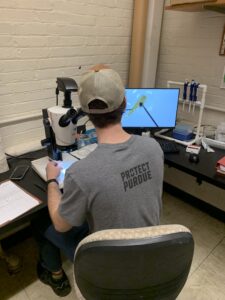
A researcher examines larval fish samples under a microscope. (Photo provide by Les Warren)
In the early 1940s, a small fish from the Atlantic Ocean, alewife (Alosa pseudoharengus), invaded the freshwater habitats of the Great Lakes. Lake Michigan was not excluded from this invasion, and alewife quickly spread throughout the lake. High densities of alewife began to degrade critical habitats and alewife carcasses clogged water intake pipes after winter die-offs. In the 1960s, successful stocking of Pacific salmonids like Coho and Chinook Salmon provided a much-needed predator for alewife. This led to both a decline in the alewife population and the establishment of a major recreational salmonid fishery.
Salmonids have since then become one of the largest recreational fisheries in Lake Michigan, and tourism and charter fishing targeting Pacific salmonids provide a strong economic impact for the surrounding states. Since the early 2000s, however, alewife populations have been on the decline and are currently at an all-time low. This decline in abundance could be attributed to several factors, including habitat degradation and the over-stocking of salmonid species. Although some species of salmonids are flexible in their diets, Coho and Chinook Salmon rely heavily on alewife for up to 90% of their diet.
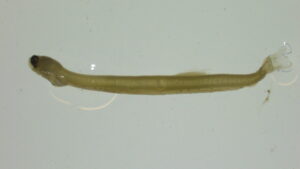
A larval alewife collected from Lake Michigan. (Photo provide by Les Warren)
Les Warren, a PhD student in Hook Lab at Purdue University Department of Forestry and Natural Resources, is studying the early life history of alewife and how different habitats may influence the survival and growth of alewife in Lake Michigan. Alewife spawn in multiple habitats in Lake Michigan, including drowned river mouth lakes (DRMLs), tributaries, and nearshore environments. Due to its large volume compared to other habitats, the nearshore region of Lake Michigan has been considered the primary source of alewife recruits by previous studies using modeling approaches. However, the main basin of Lake Michigan has undergone ecological changes such as lower productivity offshore, greater water clarity and lower food web changes. These changes are attributed to actions such as lower nutrient loading from tributaries into the lake and the invasion of dreissenid mussels, which aggressively filter the water column. In the past, habitats like DRMLs provided warm, highly turbid environments with relatively high abundance of prey for young alewife to eat. Previous studies have observed young alewife in these environments experience relatively early hatch dates, high growth rates, and higher probability of survival than that of young alewife reared in the main basin of Lake Michigan.
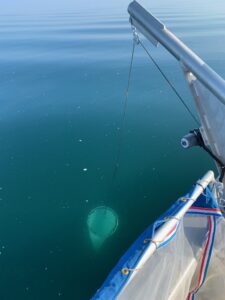
A net to capture zooplankton is towed vertically through the water. (Photo provide by Les Warren)
Over the summers of 2021 and 2022, Les sampled nearshore habitats of Lake Michigan and supplemental habitats such as DRMLs and tributaries. Sampling locations included Muskegon Lake, White Lake, Trail Creek, and the Saint Joseph River on the eastern shoreline of Lake Michigan. At each location, larval alewife were collected using a paired bongo net and surface neuston net. A paired bongo net contains two nets of different mesh sizes to facilitate the capture of various sized larvae throughout the water column. Neuston nets target larval fish at the surface of the water column. Along with the larval fish tows, zooplankton, sonde profiles, ultraviolet radiation profiles, and secchi depths were collected to further compare these habitats spatially and temporally. With the collection of zooplankton at each site, Les was able to quantify the abundance of prey available for larval fish. Secchi depth is a way to compare water clarity between habitats and connects directly with exposure to ultraviolet radiation. One exciting aspect of this study was the ability to work with collaborators at Miami University to assess the amount of potential UV exposure for larval fish in each of these habitats.
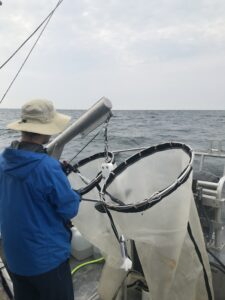
A researcher examines bongo nets after they have been towed in Lake Michigan. (Photo provide by Les Warren)
Sampling on a weekly basis during two consecutive summers was a logistical challenge. Sampling for Les’s project required scheduling around weather, scientists’ time, and plans to share equipment with the other graduate students and researchers in his lab. However, Les claims that the real work began after bringing all the samples back to the lab. Each sample needed to be picked for larval fish since the nets are rinsed down and the resulting samples are concentrated on the boat. Undergraduate technicians sorted through other matter, including algae and zooplankton, to extract the larval fish from the samples. Once picked, the larvae species were identified before extracting otoliths — ear stones that exhibit alternating light and dark rings, similar to those of a tree — to determine the ages of the larval alewife.
Although the results of the study are in the early stages, the DRML and river mouth habitats were warmer, more turbid, and had higher zooplankton densities than Lake Michigan. Larval alewife emerged on average two weeks earlier in these habitats and, overall, relative larval densities and daily growth rates of larval alewife were higher in the DRMLs and river mouths compared to the nearshore waters of Lake Michigan during both sampling seasons. Results from this study will be compared to a previous study performed 20 years earlier to provide evidence that DRMLs and river mouths are becoming increasingly important habitats to sustaining a healthy alewife population in Lake Michigan.
Illinois-Indiana Sea Grant is a partnership between NOAA, University of Illinois Extension, and Purdue University Forestry and Natural Resources, bringing science together with communities for solutions that work. Sea Grant is a network of 34 science, education and outreach programs located in every coastal and Great Lakes state, Lake Champlain, Puerto Rico and Guam.
Contact: Carolyn Foley
August 2nd, 2023 by Carolyn Foley
Meet Our Grad Student Scholars is a series from Illinois-Indiana Sea Grant (IISG) celebrating the graduate students doing research funded by the IISG scholars program. To learn more about our faculty and graduate student funding opportunities, visit our Fellowships & Scholarships page. Jin Yi (Jeanie) Tan is a second-year student in the Pharmaceutical Sciences Doctoral Program at the University of Illinois at Chicago (UIC). Her research is focused on developing an “environment to bioassay” antibiotic discovery approach while collaborating with local community centers—this is part of an educational effort to pair graduate-level research with outreach programs. As part of her work funded by Illinois-Indiana Sea Grant, she has also trained in scientific diving to explore the capacity of bacteria derived from Lake Michigan to produce new antibiotic sources.
Across the globe, superbugs—bacteria or fungi known to cause infections—are on the rise. The antimicrobial resistance crisis has become one of the most significant threats to public health. Without mobilized efforts to discover new antibiotics, the World Health Organization estimates about 10 million deaths related to antimicrobial resistance will occur per year by 2050.
To address this, graduate student Jin Yi (Jeanie) Tan is focused on finding novel drug-leads to combat multi-drug resistant bacteria by harnessing the power of their natural enemy: other bacteria. For millions of years, bacteria have fought one another with specialized chemical weapons. As a result of this evolutionary antagonism, microorganisms are a major source of antibacterial drugs.
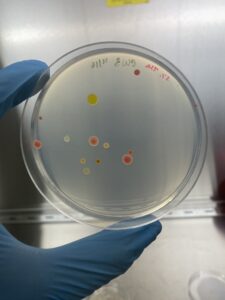
Bacteria colonies that will be examined for potential antibiotic drug leads. Photo credit J. Tan.
Studying in the laboratory of Brian Murphy, a medical chemist at the University of Illinois at Chicago, Tan has been developing a new environment to bioassay antibiotic discovery approach using robotics to rapidly select, screen, and prioritize prolific antibiotic-producing bacteria from the environment. This approach streamlines the front-end of microbial drug discovery by enabling most steps to be performed in a semi-automated fashion. In fact, parts of the process were conceptually simple enough for Tan to be able to teach them to middle school students.
Through support as an Illinois-Indiana Sea Grant Graduate Student Scholar, Tan’s work builds on a current IISG-funded initiative led by Murphy. Tan’s research is integrated with an educational outreach program in partnership with local community centers to bridge the gap that exists between universities and their surrounding communities.
One such partnership is with the James Jordan Boys and Girls Club of Chicago, an organization in a near west side neighborhood that is home to over 32,000 Chicagoans and houses groups that are predominantly underrepresented in STEM. The afterschool program, Chicago Antibiotic Discovery Lab, brings students along for a practical learning experience while they hunt for antibiotics in their own neighborhoods. Lessons go beyond the classroom to ignite a sense of curiosity in students to engage in STEM, as well as provide exposure to careers in the environmental and biomedical sciences.
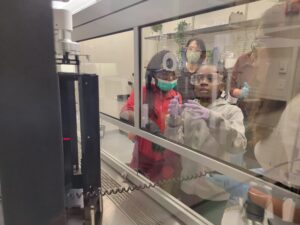
Students from the James Jordan Boys and Girls Club of Chicago meet the robot that will help pick their bacterial colonies. (Photo provided by Jin Yi “Jeanie” Tan)
So far, the program has led and educated 19 students (6th to 8th grade) in multiple steps of Great Lakes-based antibiotic discovery. They have engaged in three different local sample collections from both land and water environments, which included sediment, plants, and swabs of various surfaces. Students completed multiple tasks related to their samples—instilling a sense of ownership over their results—and performed applied science experiments in parallel with their mentors. This includes 1) growing bacteria, 2) programming a robot to isolate them by the hundreds/thousands, and 3) testing the ability of each one to inhibit the growth of deadly pathogens. The ultimate goal is to identify a new antibiotic from one of the bacteria.
Back in the lab, Tan is working on the top three samples that have shown promising growth inhibition against Staphylococcus aureus, a human pathogen well-known for causing life-threatening clinical infections. She is using a combination of chromatography and spectroscopy to identify novel antibiotics. Tan plans to publish her results and make a blueprint of the program available for others to create or improve similar university-community partnerships.
Besides the samples collected by her students, Tan is particularly interested in exploring aquatic bacteria to find new chemistry to combat infectious diseases. The Great Lakes serve as an excellent resource for this discovery effort, and chances of finding novel molecules is dependent on the biodiversity present in these aquatic ecosystems. As part of her training, she has been certified for underwater microbial sample collection by SCUBA and plans to perform scientific dive expeditions in various parts of Lake Michigan for antibiotic discovery.

A student from the James Jordan Boys and Girls Club of Chicago collects samples from local waterways.(Photo provided by Jin Yi “Jeanie” Tan)
“I’m excited to start scientific diving this summer and to share my experience with students,” said Tan. “By understanding the bio-assets from Lake Michigan and promoting scientific knowledge about bacteria and their essential roles in medicine, we want to bring a different perspective on why it is critical to protect the region’s biodiversity.”
Illinois-Indiana Sea Grant is a partnership between NOAA, University of Illinois Extension, and Purdue University Forestry and Natural Resources, bringing science together with communities for solutions that work. Sea Grant is a network of 34 science, education and outreach programs located in every coastal and Great Lakes state, Lake Champlain, Puerto Rico and Guam.
Contact: Carolyn Foley
July 25th, 2023 by Carolyn Foley
Meet Our Grad Student Scholars is a series from Illinois-Indiana Sea Grant (IISG) celebrating the graduate students doing research funded by the IISG scholars program. To learn more about our faculty and graduate student funding opportunities, visit our Fellowships & Scholarships page. Colleen O’Brien is a doctoral student in the McCormick School of Engineering at Northwestern University. She is currently in her fourth year in the program and her research looks at the performance of green infrastructure for flood reduction and water quality improvements. In the work funded by Illinois-Indiana Sea Grant, she investigates how urban green space may impact water temperature in the Chicago River. Her broader interests focus on how nature-based solutions can help cities adapt to climate change.
Cooler temperatures, better air quality, community spaces, and places to exercise – these are just a few of the environmental and social benefits that urban green spaces provide. More and more frequently, spaces like parks, gardens, and nature preserves are being relied upon by residents of urban areas for a host of benefits. One of these is stormwater management. Green infrastructure, which includes rain gardens, bioswales, and green roofs, can help reduce flooding and improve water quality. This is important as stormwater management will become an increasingly difficult problem to address as urbanization increases and effects of climate change, like warming temperatures or changing rainfall patterns, become a reality. However, many questions on the performance of green infrastructure remain. Understanding how the design of green infrastructure impacts its ability to reduce flooding and improve water quality is critical to ensure these spaces provide maximum benefits. That’s where monitoring and modeling come in.
Monitoring green infrastructure, for example with sensors that measure soil moisture, water level, and outflow from a given rain garden or bioswale, can help answer questions like, “Does the type of green infrastructure installed impact the amount of water that can be stored?” or “Do certain types of vegetation growing in a rain garden do a better job of improving water quality than others?”. But monitoring cannot address all the questions posed by scientists or urban planners, especially when aiming to expand an individual green infrastructure site to a regional scale. This is when modeling can help.

Along the Chicago River.
With support from Illinois-Indiana Sea Grant, Colleen O’Brien used ArcGIS, a mapping software, and the Minnesota Urban Heat Export Tool (MINUHET), a modeling software for thermal analysis of streams and rivers, to investigate the impact of green infrastructure and urban green spaces on water temperatures in the Chicago River. Water temperature is often called the master variable of water quality because it has a wide range of impacts on ecosystem health. Warmer water temperatures decrease the ability of water to hold chemicals like oxygen, can affect aquatic nutrient cycles, and can reduce the growth of fish and other organisms. Climate change, urbanization, and industrial and wastewater outflows have all contributed to increases in river water temperatures across the world, but this effect has been especially noticeable in cities.
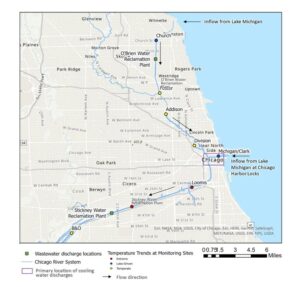
A map showing temperature data along the Chicago River.
In the Chicago region, particular concerns are that warmer water temperatures may cause more frequent algal blooms and may increase the spawning rates of invasive carp, several fish species that pose major risks to aquatic ecology and biodiversity. Green infrastructure has the potential to reduce thermal pollution, the degradation of water quality due to anthropogenic changes in water temperature. At a small scale, green infrastructures can reduce the temperature of stormwater runoff that flows into the Chicago River. At a larger scale, green infrastructure can reduce the amount of stormwater runoff overall and can help reduce the urban heat island effect, lowering the temperature of both stormwater and the air. However, due to different sizes and locations of green spaces in the urban area, the magnitude of these impacts on the changes in water temperature are still largely unknown.

A map showing the outline of catchment areas used in the modeling exercises.
Using temperature data for the Chicago River collected by the Metropolitan Water Reclamation District of Greater Chicago from 2017-2021, O’Brien is able to determine the drivers of water temperature and investigate the impact of green spaces at different scales (i.e., small green spaces along the river bank versus large green spaces within the catchment area). She uses ArcGIS to delineate the catchment areas—the areas from which rainfall flows into a river, lake, or reservoir—for each temperature sensor and examine the amount of green space within each catchment, then assesses the land use and green space within the area directly along the river bank. Next, she uses the modeling software MINUHET to predict the temperature of stormwater from these areas based on physical characteristics and atmospheric conditions such as land use, slope, air temperature, and relative humidity. These results provide information on what types of green spaces may be most effective at reducing thermal pollution. This can be used to inform future restoration projects to reduce thermal pollution, a key step in restoring urban river ecosystems.
As the City of Chicago continues to grow and the effects of climate change intensify, the impact of thermal pollution is likely to increase. Degradation of the Chicago River has the potential to impact the quality of Lake Michigan, a vital source of drinking water for the region. Developing a better understanding of the sources of thermal pollution within the Chicago River can inform restoration efforts and the design of green infrastructure and prevent further environmental degradation. In addition, more green spaces can improve air quality, reduce urban heat, provide spaces for recreation and social gathering, among many other community benefits.
After completing her PhD, O’Brien plans to pursue a career focused on community science and science policy, working directly with community organizations to make cities more climate resilient.
Illinois-Indiana Sea Grant is a partnership between NOAA, University of Illinois Extension, and Purdue University Forestry and Natural Resources, bringing science together with communities for solutions that work. Sea Grant is a network of 34 science, education and outreach programs located in every coastal and Great Lakes state, Lake Champlain, Puerto Rico and Guam.
Contact: Carolyn Foley
July 7th, 2023 by Carolyn Foley
Meet Our Grad Student Scholars is a series from Illinois-Indiana Sea Grant (IISG) celebrating the graduate students doing research funded by the IISG scholars program. To learn more about our faculty and graduate student funding opportunities, visit our Fellowships & Scholarships page. Emma Donnelly is a master’s student in the School of Environmental Sustainability at Loyola University Chicago. Her thesis research is focused on residential mobility and the value of water quality restoration in Great Lakes Areas of Concern.
For decades, legacy pollutants from historical industrial activities have created health concerns for residents in the Great Lakes region. High costs are often a burden in the cleanup process and become a continuous obstacle in tackling water quality issues that affect residents and wildlife. Loyola student Emma Donnelly is conducting research that provides promising insights into the economic benefits of investing in remediation of heavily polluted locations around the Great Lakes. Cleaner water and healthier ecosystems have the potential to expand opportunities for development and recreation, while enhancing local economies and wildlife habitats.
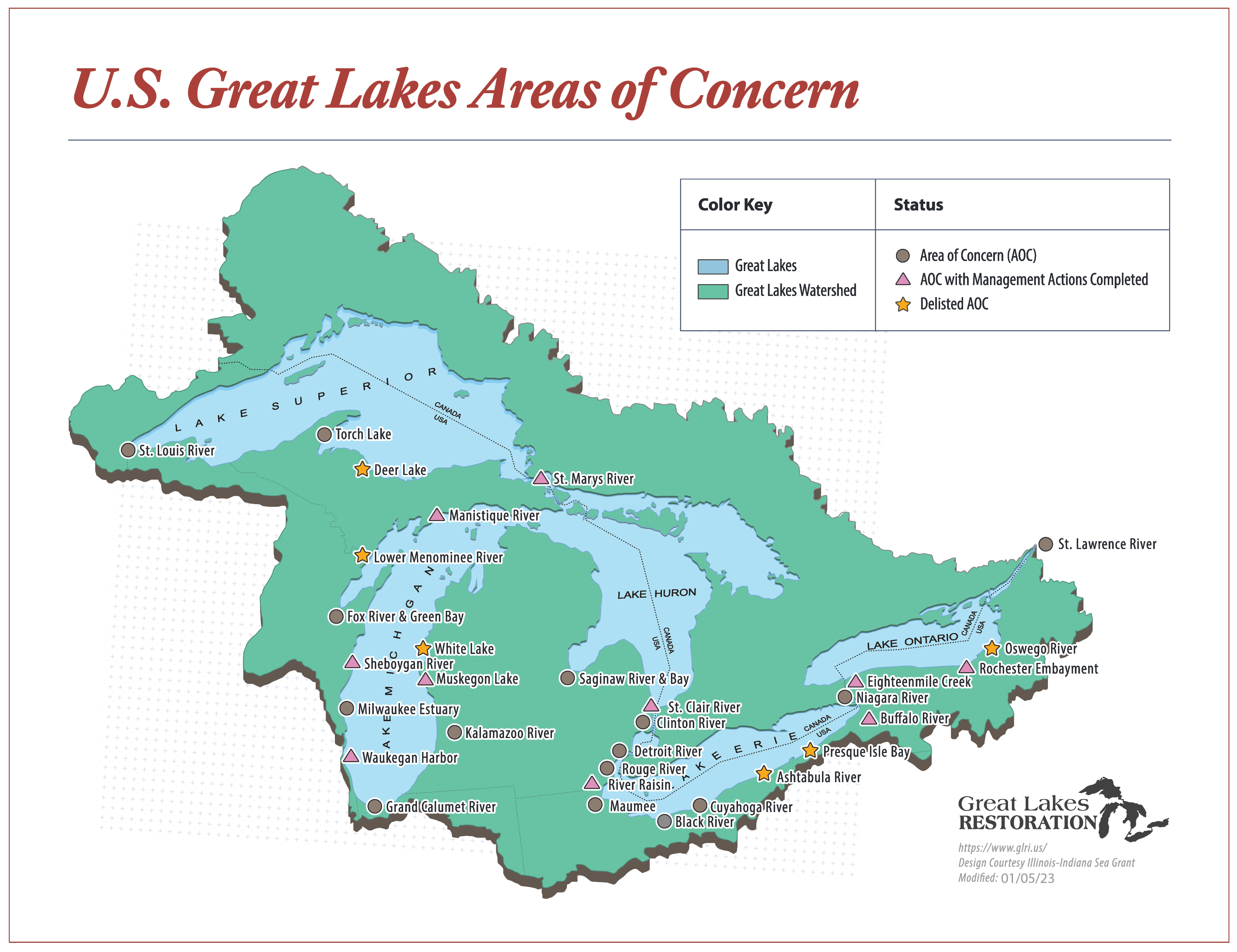
Location and status of the U.S. Great Lakes Areas of Concern. Updated January 5, 2023.
Legacy pollutants, well-known industrial substances, including polychlorinated biphenyls (PCBs) and polycyclic aromatic hydrocarbons (PAHs), not only create health concerns for communities but also threaten the wellbeing of wildlife and limit recreational activities and development of coastal areas. In 1987, the United States and Canada established the Great Lakes Water Quality Agreement in an effort to address concerns about legacy pollutants in the region. This agreement established Great Lakes Areas of Concern (AOCs) to be prioritized for cleanup. Between 1985 and 2019, the United States and Canada spent $22.78 billion restoring AOCs. This has prompted people to ask questions such as: Do the benefits of cleanup outweigh the costs? Might additional cleanup be worth it? Answering questions like these is essential to evaluating the cost-effectiveness of the AOC program.
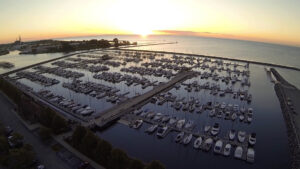
Waukegan Harbor. Image source: https://www.visitlakecounty.org/WaukeganHarborandMarina.
Waukegan Harbor in northeastern Illinois is one of the 43 AOCs designated through the Great Lakes Water Quality Agreement. Legacy pollutants were first discovered in the harbor in 1975. Since its listing as a Superfund site in 1981 and designation as an AOC in 1987, the Waukegan Harbor AOC has undergone significant remediation. It currently holds the status of “Management Actions Complete,” meaning that all cleanup projects have finished and the AOC is being monitored for delisting.
Over $73 million has been invested in contaminated sediment remediation in Waukegan Harbor. Measuring the economic effects of restoration is essential to understanding the consequences of remediation. In many AOCs, there is a stigma associated with contamination of the water, so remediation of the harbor could contribute to new economic activity in downtown Waukegan. The harbor provides a space for employment at industrial facilities as well as recreational opportunities at public parks and beaches on Lake Michigan, and access to these uses—resulting in economic benefits to the city—can be improved through cleanup.
The goal of Emma Donnelly’s research is to estimate the economic value of restoring the Waukegan Harbor AOC. Her methodology uses an analysis of house sales in Waukegan before and after several milestones of cleanup progress. The analysis relates home prices to property characteristics, including proximity to the boundaries of the AOC. Specifically, in her study, Donnelly examines the effect of the removal of Beneficial Use Impairments (BUIs) on home values. BUIs are water uses that have been restricted because of pollution (e.g., restrictions on recreation and consumption of fish). An AOC is delisted once all of its BUIs have been removed. In the Waukegan Harbor AOC, five BUIs were removed between 2011 and 2020. Only one BUI has yet to be removed—restrictions on fish and wildlife consumption—although it is expected to happen by 2026.
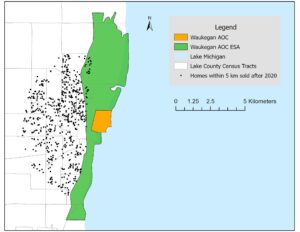
Map of the Waukegan Harbor Area of Concern (AOC) and Extended Study Area (ESA), plus locations of nearby homes that have been sold since 2020.
Donnelly’s analysis provides evidence that local residents value the cleanup of the Waukegan Harbor. The results of the hedonic analysis of Waukegan Harbor indicate that home prices increased by $12,832 per household, or $169 million in aggregate for all households within five kilometers of the AOC.
Donnelly also finds the benefits of the cleanup only emerged after the fifth BUI was removed, suggesting that substantial cleanup may be required before benefits capitalize into housing prices. Her results indicate that the benefits are concentrated in homes approximately 1 to 3 kilometers from the harbor, and that benefits decrease with distance from the harbor. This is consistent with prior research that suggests that the benefits of cleanup diminish for homes that are far from the site of cleanup. She believes one reason why she does not find benefits for homes within one kilometer could be because of the nearby industrial area, highway and railroad surrounding the harbor, which separates homes from the immediate vicinity of the AOC; in fact, there are very few homes located within one kilometer of the harbor. Also, other location characteristics that are part of the industrial setting could have lessened the effect of the cleanup on home prices. Overall, Emma’s findings may suggest that for industrial areas with degraded water quality, where households are not located immediately adjacent to the water, substantial progress toward full restoration may be required before benefits start to capitalize in home values.
Sources:
Thirty-five years of restoring Great Lakes Areas of Concern: Gradual progress, hopeful future – ScienceDirect
Waukegan Harbor AOC | US EPA
Waukegan Harbor Remedial Action Plan. Final Stage III Report – Waukegan Harbor RAP – July 1999
Illinois-Indiana Sea Grant is a partnership between NOAA, University of Illinois Extension, and Purdue University Forestry and Natural Resources, bringing science together with communities for solutions that work. Sea Grant is a network of 34 science, education and outreach programs located in every coastal and Great Lakes state, Lake Champlain, Puerto Rico and Guam.
Contact: Carolyn Foley
May 17th, 2023 by Carolyn Foley
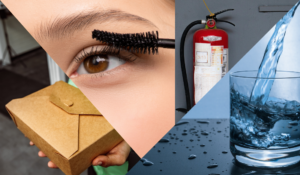
Per- and polyfluoroalkyl substances (PFAS) are a suite of hundreds-to-thousands of manufactured “forever chemicals” that are persistent in nature and toxic to many organisms. Additional chemical precursors, metabolites, or degradates to PFAS and related substances exist in nature and have potential to be toxic to many organisms. While much remains to be learned about the fate and transport of PFAS and related compounds in the environment, people and communities are currently being impacted by the ubiquitous nature of PFAS and related compounds—for example, in drinking water, food, packaging, personal care products, and building materials.
With support from the National Sea Grant Office, the Illinois-Indiana Sea Grant College Program (IISG) has $400,000 to invest in promising research projects relevant to social and economic impacts of PFAS exposure, mitigation, and remediation in the Great Lakes and Lake Champlain regions. For purposes of this competition, “PFAS” refers to any component of the suite of per- and polyfluoralkyl substances and related compounds, including precursors. Work is to be conducted between October 1, 2023 and March 31, 2025. Work can be conducted anywhere in the Great Lakes and Lake Champlain regions so long as it supports the priorities identified in this document. Priorities were identified via a series of scoping activities (3 workshops, 1 survey) in early 2023.
A full report of the scoping effort, which includes additional details on key demographic groups and research needs for the regions, can be found at the project webpage. The full request for proposals including submission guidance is available, but a synopsis is also provided below.
Projects should propose to answer a clear research question or set of related questions, should focus on one or more groups that live, work, and/or recreate in the Great Lakes and Lake Champlain regions, and should demonstrate fit with one or more of the following research priorities. The priorities are not listed in any particular order.
Understanding exposure to PFAS
- Improved understanding of how different groups or communities may be differentially exposed to PFAS, e.g., higher consumption of fish on a regular basis; use of well or other waterways that are not regularly monitored or not currently monitored
- How exposure and consumption to PFAS translates within the context of traditional knowledge
Communicating risks and actions for PFAS
- How to best communicate uncertainty surrounding the scientific knowledge of PFAS and its effects, while also ensuring members of the public, or specific communities (e.g., those at higher risk of PFAS exposure, those more susceptible to effects of PFAS) take appropriate action to keep themselves safe
- How to effectively communicate taking action(s) that are most successful at reducing or preventing PFAS exposure
Economic impacts of PFAS
- What are the economic impacts of PFAS contamination on communities, considering matrices such as drinking water, fish consumption, solid waste application
- Cost-benefit analyses of the most effective and efficient treatment methodologies for PFAS
Policies and regulations for PFAS
- How to implement effective policies and regulations around PFAS including at local, regional, and international levels
- Examination of the potential impacts of total vs. partial bans of PFAS
Prospective PIs must submit a letter of intent at least 4 weeks before the full proposal submission date. Letters of intent should be emailed to iisg@purdue.edu by July 3, 2023.
Applicants who provided a letter of intent on time should submit all proposal materials via https://esg.iiseagrant.org/ by 11:59 p.m. Central time on July 31, 2023. Applications should be submitted to the “Regional PFAS Research Competition.”
Questions about this opportunity should be directed to BOTH Amanpreet Kohli (kohli19@purdue.edu) and Carolyn Foley (cfoley@purdue.edu).
Illinois-Indiana Sea Grant is a partnership between NOAA, University of Illinois Extension, and Purdue University Forestry and Natural Resources, bringing science together with communities for solutions that work. Sea Grant is a network of 34 science, education and outreach programs located in every coastal and Great Lakes state, Lake Champlain, Puerto Rico and Guam.
Contact: Carolyn Foley, Sarah Zack
March 16th, 2023 by Carolyn Foley
Chances are good that you’ve heard the term “PFAS” in the news, including that they are “forever chemicals” found at airports and military sites but also in everyday household items like pots and pans, makeup and drinking water. While scientists know that PFAS are per- and polyfluoroalkyl substances, have very strong bonds that allow them to persist in nature, and exist in hundreds of different forms, there is still much to learn.
In 2022, Illinois-Indiana Sea Grant (IISG) was awarded a grant from the National Sea Grant Office to help explore this issue. Specifically, IISG plans to support a Great Lakes and Lake Champlain regional research competition focused on social and economic issues related to PFAS risk, exposure and remediation. But first, the project team sought to review the status of PFAS research knowledge and needs in the Great Lakes and Lake Champlain region. The team hosted three scoping sessions in March 2023, focused on PFAS risk and exposure, PFAS mitigation and remediation, and PFAS governance and prevention.

Project Coordinator Aman Kohli reviews the agenda and introduces the speakers during the first session.
More than 60 participants from federal, state, provincial, tribal, consulting and academic institutions joined over the course of the three sessions. Presentations and discussions centered around three main questions:
- Which communities are at risk, and what are their sources and routes of exposure?
- What are the socioeconomic barriers to the adoption and implementation of some of the current/proposed solutions, and what are their alternatives?
- What information is needed to ensure all who live, work and recreate in the Great Lakes region are treated in a just and equitable way with respect to governance and prevention of PFAS contamination and exposure?
Participants shared many thoughts and ideas beyond those that will be incorporated into a Great Lakes and Lake Champlain regional request for research proposals (RFP) to be issued in May 2023. The project team—which includes IISG Director Tomas Höök, IISG Research Coordinator Carolyn Foley, IISG Pollution Prevention Specialist Sarah Zack and Project Coordinator Aman Kohli—plans to issue a publicly available workshop report in spring 2023 that includes ideas shared, research and information needs, and other concepts for further exploring PFAS in the Great Lakes and Lake Champlain region.
If you would like to receive emails related to funding competitions, including when they are open, please subscribe to our research mailing list. *Note that Purdue Mailman services are secure despite some warnings that may pop up.
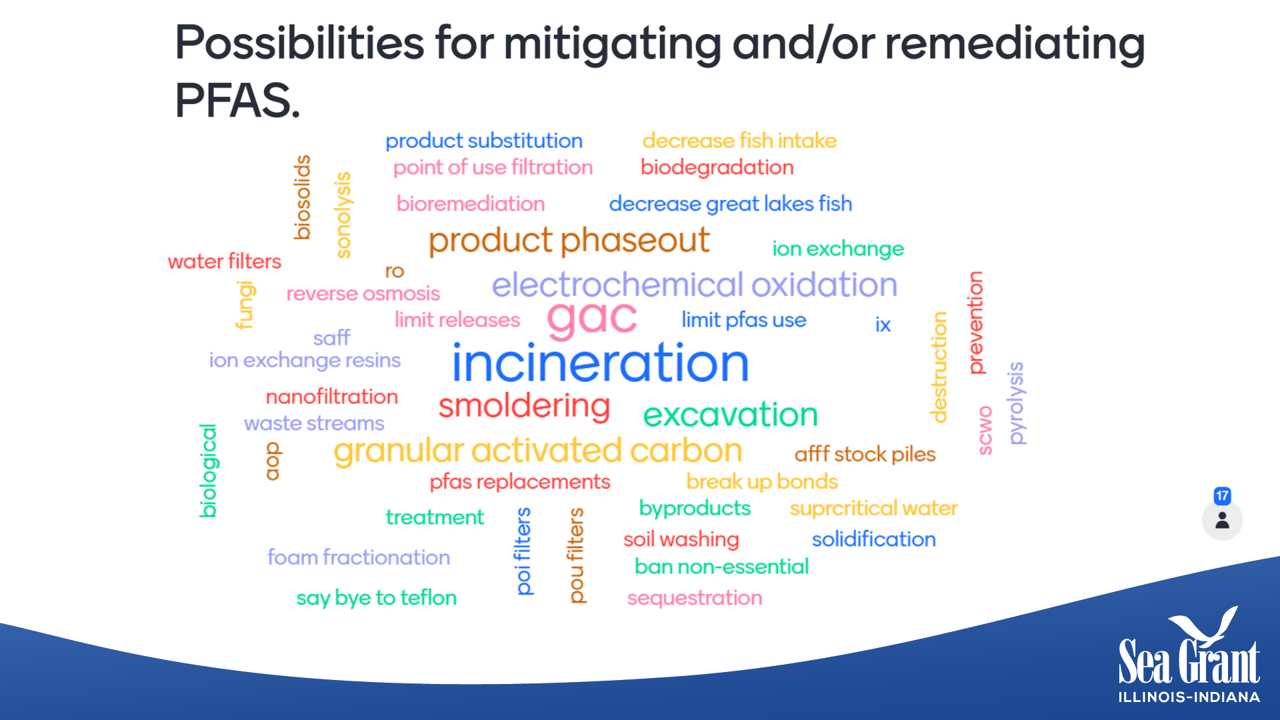
A word cloud generated during an exercise in the second PFAS scoping session.
Illinois-Indiana Sea Grant is a partnership between NOAA, University of Illinois Extension, and Purdue University Forestry and Natural Resources, bringing science together with communities for solutions that work. Sea Grant is a network of 34 science, education and outreach programs located in every coastal and Great Lakes state, Lake Champlain, Puerto Rico and Guam.
Contact: Carolyn Foley, Sarah Zack
November 29th, 2022 by Carolyn Foley
The Illinois-Indiana Sea Grant College Program (IISG) anticipates having $800,000 to invest in promising research projects relevant to southern Lake Michigan and surrounding coastal communities in northeast Illinois and northwest Indiana. Work is to be completed in the 2024-25 biennium. Work can be conducted outside of the geographic area outlined above provided applicants make a compelling case for why their work is relevant to southern Lake Michigan and surrounding coastal communities.
For the 2024–25 cycle, IISG will prioritize funding projects with outcomes that demonstrate potential to benefit underserved communities in the southern Lake Michigan region. Benefits may include but are not limited to improved quality of life, job training and student opportunities, and increased access to beneficial services or information.
IISG encourages submissions by early career scientists and/or persons who have partnered with, or plan to mentor, early career scientists. IISG also encourages all applicants to make research plans such that their work will effectively center on underrepresented racial and ethnic groups, people with disabilities, and/or people from economically or educationally disadvantaged backgrounds that have limited their ability to pursue a career in STEM.
Eligibility
Investigators from educational or research institutions including universities, museums, and NGOs, are eligible to serve as PI for these funds. Priority will be given to Illinois- and Indiana-based researchers. Researchers from other states are welcome to apply but proposed work must demonstrate how it will benefit the mission of IISG and/or meet research priorities.
Research Topics
Projects should propose to answer a clear research question or set of related questions, and should demonstrate fit with the IISG strategic plan. Five areas are of special interest for the 2024-25 funding cycle:
- Improving water safety, with a goal of reducing the number of drownings in Lake
Michigan.
- Adapting to changing lake levels in the southern Lake Michigan region in support of
healthy coastal ecosystems and resilient communities and economies.
- Better understanding contaminant levels in fish or shellfish that are or can be used for food. These may include Lake Michigan or tributary fish caught for subsistence fishing or Illinois- or Indiana-farm raised fish and shellfish. Contaminants to explore include but are not limited to legacy contaminants, contaminants of emerging concern, and toxic cyanobacteria from algal blooms (e.g., in nearshore regions; in ponds where fish or shellfish are raised).
- Addressing environmental justice concerns associated with restoration of degraded
southern Lake Michigan coastal sites (e.g., decommissioned power plants, industrial
parks).
- Exploring economic or legal barriers to production of Illinois- and/or Indiana-grown
fish or shellfish (e.g., processing of organisms to be sold at restaurants, permitting or
acquisition of resources to expand facilities, access to skilled laborers).
Additional topic areas of interest include broader aquaculture research, aquatic invasive species, community climate readiness, fisheries, healthy waters and pollution prevention, recreation and tourism, stormwater and green infrastructure, shoreline erosion, sustainable community planning, and water supply. All research projects should fit at least one of these topic areas.
Preproposal Submission
Prospective PIs must submit a preproposal to be considered for funding. Applicants should submit materials via https://esg.iiseagrant.org/ by 11:59 p.m. Central time on February 6, 2023. Applications should be submitted to the “IL-IN SG 2023 2-Year Research Competition”. Late applications will not be accepted unless the applicant has contacted IISG staff members before the deadline to make them aware of potential issues, (e.g., computer, power, or internet issues). IISG reserves the right to refuse late applications if the program determines that individual circumstances do not warrant an extension. IISG staff members will only be available to answer questions until 5:00 pm Central time on February 6, 2023.
The full RFP can be found at https://iiseagrant.org/wp-content/uploads/2022/11/IISG-RFP-2022.pdf. Questions regarding eligibility or submission requirements may be directed to Carolyn Foley at cfoley@purdue.edu or by phone at 765-494-3601.
Illinois-Indiana Sea Grant is a partnership between NOAA, University of Illinois Extension, and Purdue University Forestry and Natural Resources, bringing science together with communities for solutions that work. Sea Grant is a network of 34 science, education and outreach programs located in every coastal and Great Lakes state, Lake Champlain, Puerto Rico and Guam.
November 15th, 2022 by Carolyn Foley
One of Illinois-Indiana Sea Grant’s (IISG) long-term goals is to help build a community of researchers and outreach professionals focused on critically important Lake Michigan issues. The IISG Scholars programs are designed to help build this community by introducing researchers to the issues and the individuals, organizations, and communities that are affected by them. In addition, the programs are intended to help graduate student scholars further the impact of their research, and help faculty scholars develop innovative, fundable proposals for future work in the region. View examples of past scholar projects in our newsroom.
The 2023 IISG Scholars competition is now open for Graduate Students and Faculty. Awards are issued for one year and activities should be completed during that year. IISG expects to support 4–5 Graduate Student Scholars and 6 Faculty Scholars in 2023. For 2023, at least three of the funded Faculty Scholar projects are expected to focus on research that supports resiliency along shorelines and in coastal communities. Learn more by reading the full Request for Applications.
Applicants for both opportunities (graduate students and faculty) should submit materials via https://esg.iiseagrant.org/ by 11:59 p.m. Central time on January 20, 2023. Applications should be submitted to the “IL-IN SG 2023 Scholars Competition”. Late applications will not be accepted unless the applicant has contacted IISG staff before the deadline to make them aware of potential issues (e.g., computer, power, or internet issues). IISG staff reserve the right to refuse late applications if the program determines that individual circumstances do not warrant an extension.
Questions about this opportunity should be directed to IISG Research Coordinator Carolyn Foley at cfoley@purdue.edu. IISG staff will only be available to answer questions until 5:00 pm Central Time on January 20, 2023.
Illinois-Indiana Sea Grant is a partnership between NOAA, University of Illinois Extension, and Purdue University Forestry and Natural Resources, bringing science together with communities for solutions that work. Sea Grant is a network of 34 science, education and outreach programs located in every coastal and Great Lakes state, Lake Champlain, Puerto Rico and Guam.
Contact: Carolyn Foley

















